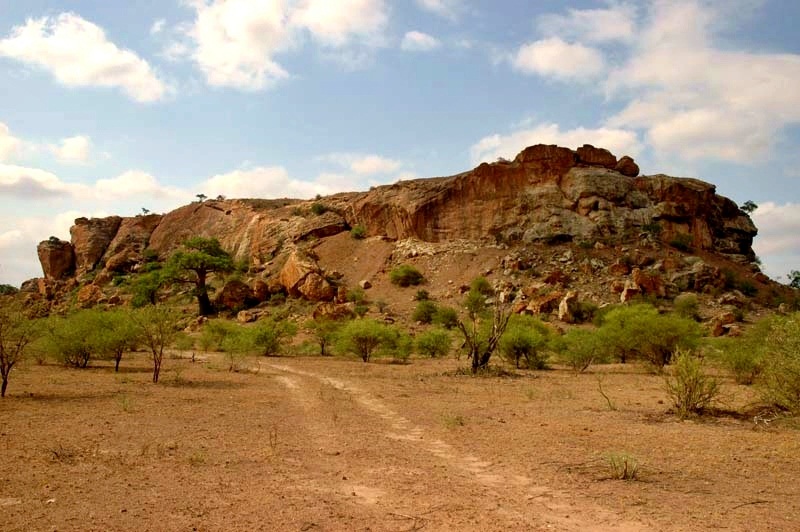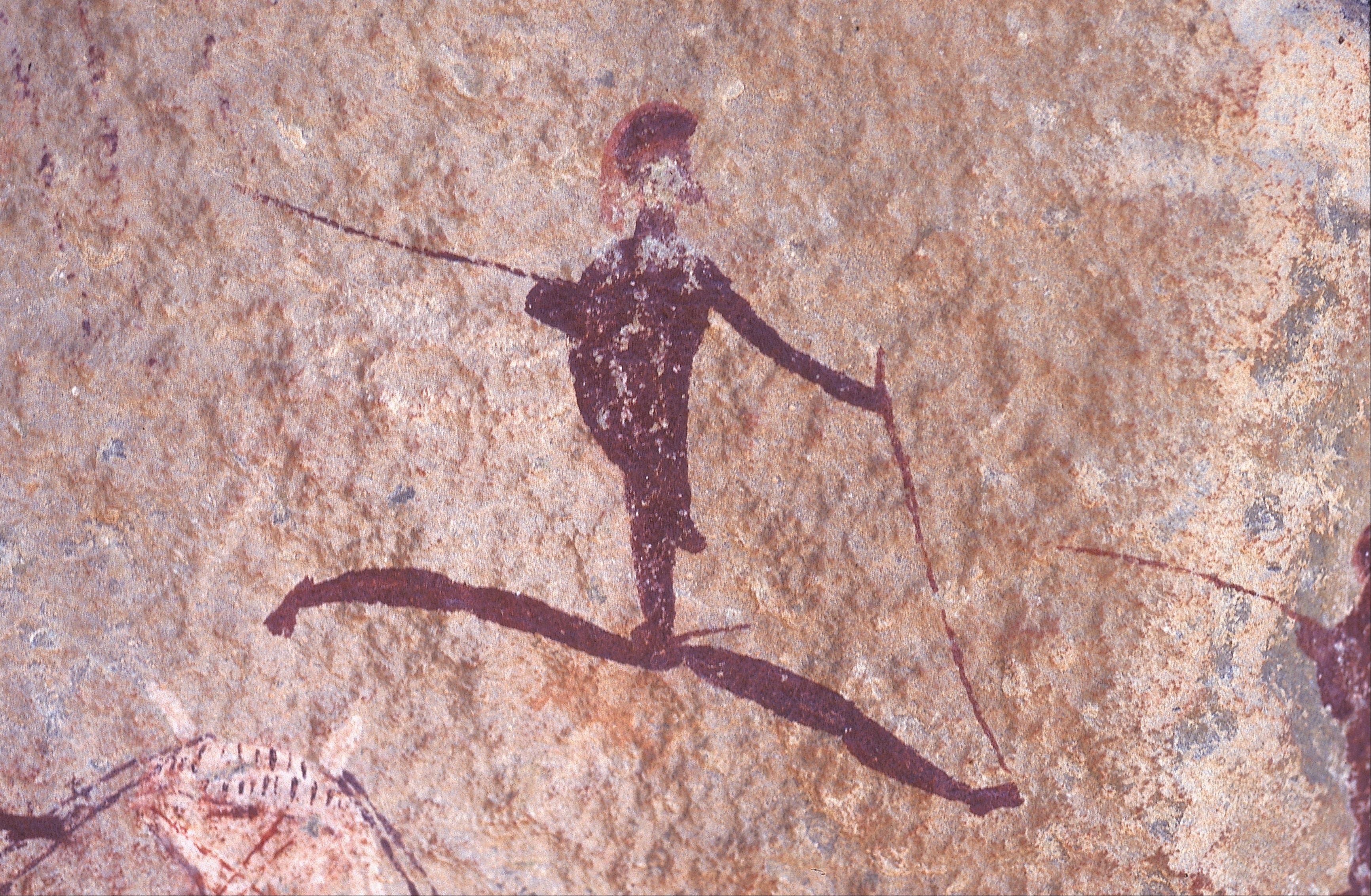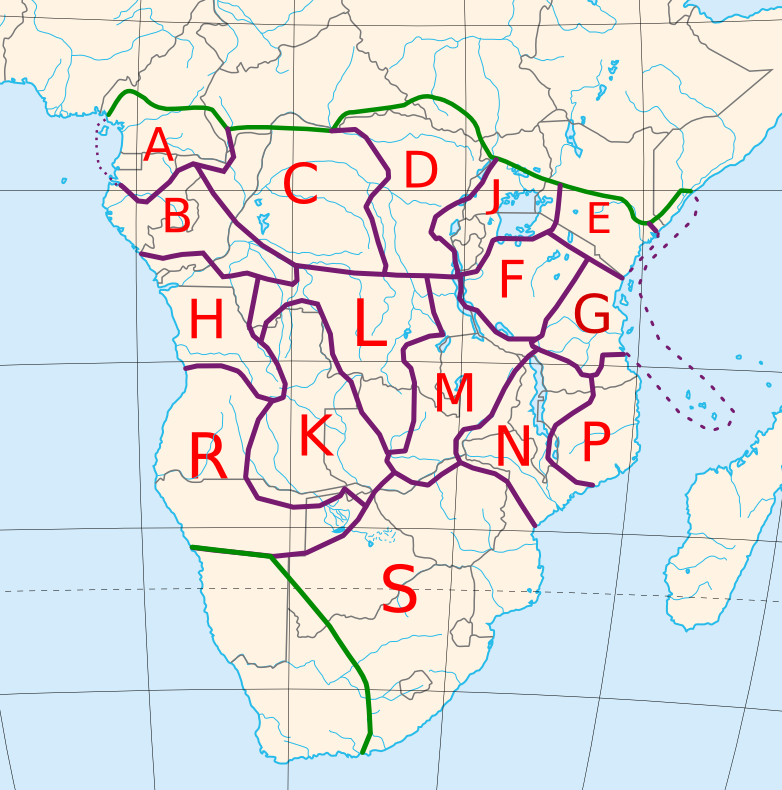|
Kingdom Of Mapungubwe
The Kingdom of Mapungubwe (pronounced ) was an ancient state located at the confluence of the Shashe and Limpopo rivers in South Africa, south of Great Zimbabwe. The capital's population was 5,000 by 1250, and the state likely covered 30,000 km² (12,000 square miles). The Mapungubwe elite further institutionalised rainmaking into the development of sacral kingship, and the kingdom exported gold and ivory into the Indian Ocean trade via Swahili city-states on the East African coast. Although traditionally assumed to have been the first kingdom in Southern Africa, excavations in the same region at Mapela Hill show evidence for sacral kingship nearly 200 years earlier. Following unknown events and shifting trade routes north around 1300, Mapungubwe's population scattered. In the present day they are often associated with the Kalanga ( Shona), Tshivhula, and Venda peoples. Despite locals having knowledge of the sacred site, Mapungubwe was only rediscovered by the scientif ... [...More Info...] [...Related Items...] OR: [Wikipedia] [Google] [Baidu] |
Shona People
The Shona people () also/formerly known as the Karanga are a Bantu peoples, Bantu ethnic group native to Southern Africa, primarily living in Zimbabwe where they form the majority of the population, as well as Mozambique, South Africa, and worldwide diaspora. There are five major Shona language/dialect clusters: Manyika, Karanga, Zezuru, Korekore, Kalanga, and Ndau. Classification The Shona people are grouped according to the dialect of the language they speak. Their estimated population is 22.6 million: * Korekore people, Korekore (northern region of Zimbabwe) * Zezuru people, Zezuru (central Zimbabwe) * Manyika tribe, Manyika (eastern Zimbabwe around Mutare, Buhera, Nyanga, Zimbabwe, Nyanga and into Mozambique) * Ndau people, Ndau (southeast Zimbabwe around Mutare, Chimanimani, Chipinge and into Mozambique) * Karanga people, Karanga (south-central Zimbabwe around Masvingo) * Kalanga people, Kalanga (southwest Zimbabwe, interspersed with the Northern Ndebele people, Ndebele ... [...More Info...] [...Related Items...] OR: [Wikipedia] [Google] [Baidu] |
Leopard's Kopje
Leopard's Kopje is an archaeological site, the type site of the associated region or culture that marked the Middle Iron Age in Zimbabwe. The ceramics from the Leopard's Kopje type site have been classified as part of phase II of the Leopard's Kopje culture. For information on the region of Leopard's Kopje, see the "Associated sites" section of this article. Location The site is located 2 kilometers north-east of the Khami World Heritage Site and 24 kilometers west of Bulawayo, Zimbabwe. Bordered by small hills, or koppies, on two sides and sharp ravines on the other two sides. The site is relatively small, measuring 150 by 200 yards in area. History K. R. Robinson conducted several excavations in the area, beginning in 1961. Thomas Huffman, who first excavated Leopard's Kopje in August 1969, is also an important archaeologist of the site. Huffman's excavations found three different phases of occupation, Zhizo, Mambo, and Refuge. Refuge phase The occupation from the 1 ... [...More Info...] [...Related Items...] OR: [Wikipedia] [Google] [Baidu] |
San Rock Art
The San, or Bushmen, are indigenous people in Southern Africa particularly in what is now South Africa and Botswana. Their ancient rock paintings and carvings (collectively called rock art) are found in caves and on rock shelters. The artwork depicts non-human beings, hunters, and half-human half-animal hybrids. The half-human hybrids are believed to be medicine men or healers involved in a healing dance.Gall, Sandy. "The Bushmen of the Kalahari." Ecologist 33.7 (2003): 28-31. Gall writes, "The Laurens van der Post panel at Tsodilo is one of the most famous rock paintings." High on this rock face in Botswana is the image of a "magnificent red eland bull" painted, according to Van der Post, "only as a Bushman who had a deep identification with the eland could have painted him." Also on this rock face is a female giraffe that is motionless, as if alarmed by a predator. Several other images of animals are depicted there, along with the flesh blood-red handprints that are the ... [...More Info...] [...Related Items...] OR: [Wikipedia] [Google] [Baidu] |
San People
The San peoples (also Saan), or Bushmen, are the members of any of the indigenous hunter-gatherer cultures of southern Africa, and the oldest surviving cultures of the region. They are thought to have diverged from other humans 100,000 to 200,000 years ago. Their recent ancestral territories span Botswana, Namibia, Angola, Zambia, Zimbabwe, Lesotho, and South Africa. The San speak, or their ancestors spoke, languages of the Khoe, Tuu, and Kxʼa language families, and can be defined as a people only in contrast to neighboring pastoralists such as the Khoekhoe and descendants of more recent waves of immigration such as the Bantu, Europeans, and South Asians. In 2017, Botswana was home to approximately 63,500 San, making it the country with the highest proportion of San people at 2.8%. 71,201 San people were enumerated in Namibia in 2023, making it the country with the second highest proportion of San people at 2.4%. Definition The term "San" comes from the Khoekhoe la ... [...More Info...] [...Related Items...] OR: [Wikipedia] [Google] [Baidu] |
Northern Sotho
Sepedi, also known as Northern Sotho, is one of South Africa’s twelve official languages and belongs to the Bantu language family, specifically the Sotho-Tswana group. The language is spoken mainly in Limpopo Province, and to a lesser extent in Gauteng, Mpumalanga, and North West''.'' Sepedi refers to the ''dialect'' spoken by the Pedi people. Northern Sotho is the umbrella term for a group of related dialects. The two terms are often used interchangeably, but technically Sepedi is one dialect of Northern Sotho. As of the 2022 South African Census, approximately 6.2 million people — or 10.0% of the national population speak Sepedi as their first language. Sepedi ranks as the fifth most spoken first language. Official language status Sepedi vs Northern Sotho According to Chapter 1, Section 6 of the South African Constitution, Sepedi is one of South Africa's 12 official languages. There has been significant debate about whether Northern Sotho should be used instead of ... [...More Info...] [...Related Items...] OR: [Wikipedia] [Google] [Baidu] |
Venda Language
Venḓa or Tshivenḓa is a Bantu languages, Bantu language and an Languages of South Africa, official language of South Africa and Zimbabwe. It is mainly spoken by the Venda people (or Vhavenḓa) in the northern part of South Africa's Limpopo, Limpopo province, as well as by some Lemba people in South Africa. The Tshivenda language is related to Shona language, Shona (Karanga and Kalanga) which is spoken in Southern Africa. During the apartheid era of South Africa, the Bantustan of Venda was set up to cover the Venda speakers of South Africa. According to the 2011 census, Venda speakers are concentrated in the following areas: Makhado Local Municipality, with 350,000 people; Thulamela Local Municipality, with 370,000 people; Musina Local Municipality, with 35,000 people; and Mutale Local Municipality, with 89,000 people. The total number of speakers in Vhembe District Municipality, Vhembe district currently stands at 844,000. In Gauteng, Gauteng province, there are 275,000 Ve ... [...More Info...] [...Related Items...] OR: [Wikipedia] [Google] [Baidu] |
Bantu Languages
The Bantu languages (English: , Proto-Bantu language, Proto-Bantu: *bantʊ̀), or Ntu languages are a language family of about 600 languages of Central Africa, Central, Southern Africa, Southern, East Africa, Eastern and Southeast Africa, Southeast Africa. They form the largest branch of the Southern Bantoid languages. The total number of Bantu languages is estimated at between 440 and 680 distinct languages, depending on the definition of Dialect#Dialect or language, "language" versus "dialect"."Guthrie (1967–71) names some 440 Bantu 'varieties', Grimes (2000) has 501 (minus a few 'extinct' or 'almost extinct'), Bastin ''et al.'' (1999) have 542, Maho (this volume) has some 660, and Mann ''et al.'' (1987) have ''c.'' 680." Derek Nurse, 2006, "Bantu Languages", in the ''Encyclopedia of Language and Linguistics'', p. 2:Ethnologue report for Southern Bantoid" lists a total of 535 languages. The count includes 13 Mbam languages, which are not always included under "Narrow Bantu". ... [...More Info...] [...Related Items...] OR: [Wikipedia] [Google] [Baidu] |
Jackal
Jackals are Canidae, canids native to Africa and Eurasia. While the word has historically been used for many canines of the subtribe Canina (subtribe), canina, in modern use it most commonly refers to three species: the closely related black-backed jackal (''Lupulella mesomelas'') and side-striped jackal (''Lupulella adusta'') of Central Africa, Central and Southern Africa, and the golden jackal (''Canis aureus'') of south-central Europe and Asia. The African golden wolf (''Canis lupaster'') was also formerly considered a jackal. While they do not form a monophyly, monophyletic clade, all jackals are opportunistic omnivores, predators of small to medium-sized animals and proficient scavengers. Their long legs and curved canine teeth are adapted for hunting small mammals, birds, and reptiles, and their large feet and fused leg bones give them a physique well-suited for long-distance running, capable of maintaining speeds of for extended periods of time. Jackals are crepuscular, ... [...More Info...] [...Related Items...] OR: [Wikipedia] [Google] [Baidu] |
Botswana
Botswana, officially the Republic of Botswana, is a landlocked country in Southern Africa. Botswana is topographically flat, with approximately 70 percent of its territory part of the Kalahari Desert. It is bordered by South Africa to the south and southeast, Namibia to the west and north, Zambia to the north, and Zimbabwe to the northeast. With a population of slightly over 2.4 million people and a comparable land area to France, Botswana is one of the List of countries and dependencies by population density, most sparsely populated countries in the world. It is essentially the nation-state of the Tswana people, who constitute nearly 80 percent of the population. The Tswana ethnic group are descended mainly from Bantu peoples, Bantu-speaking peoples who Bantu expansion, migrated into southern Africa, including modern Botswana, in several waves before AD 600. In 1885, the British Empire, British colonised the area and declared a protectorate named Bechuanaland. As part of the ... [...More Info...] [...Related Items...] OR: [Wikipedia] [Google] [Baidu] |
Pretoria
Pretoria ( ; ) is the Capital of South Africa, administrative capital of South Africa, serving as the seat of the Executive (government), executive branch of government, and as the host to all foreign embassies to the country. Pretoria straddles the Apies River and extends eastward into the foothills of the Magaliesberg mountains. It has a reputation as an academic city and centre of research, being home to the Tshwane University of Technology (TUT), the University of Pretoria (UP), the University of South Africa (UNISA), the Council for Scientific and Industrial Research (CSIR), and the Human Sciences Research Council. It also hosts the National Research Foundation (South Africa), National Research Foundation and the South African Bureau of Standards. Pretoria was one of the host cities of the 2010 FIFA World Cup. Pretoria is the central part of the City of Tshwane Metropolitan Municipality which was formed by the amalgamation of several former local authorities, including B ... [...More Info...] [...Related Items...] OR: [Wikipedia] [Google] [Baidu] |
Mapungubwe Museum
The Mapungubwe Collection, held by the University of Pretoria museums in its Old Arts Building, consists of archaeological materials excavated by the former University of Gauteng from the Mapungubwe archaeological site since its discovery in 1933. The collection includes ceramics, metals, trade glass beads, indigenous beads, clay figurines, and artifacts made from bone and ivory, alongside a research collection of potsherds, faunal remains, and other fragmentary materials. In June 2000, the University of Gauteng inaugurated the permanent museum. The collection is maintained on site, serving both educational and tourism purposes. Mapungubwe archaeological site The Mapungubwe archaeological site (pronounced ) is located at the confluence of the Shashe and Limpopo Rivers, on the borders of Zimbabwe and Botswana in the Limpopo Province of South Africa. At this site, the development of complex Iron Age societies started with the Schroda site, a Zhizo/Leokwe community, around AD 900 ... [...More Info...] [...Related Items...] OR: [Wikipedia] [Google] [Baidu] |






